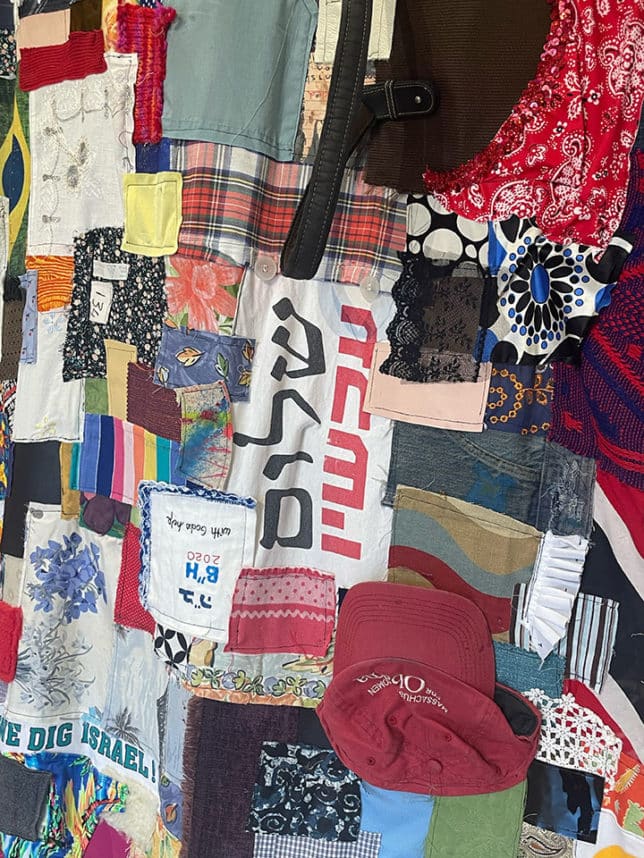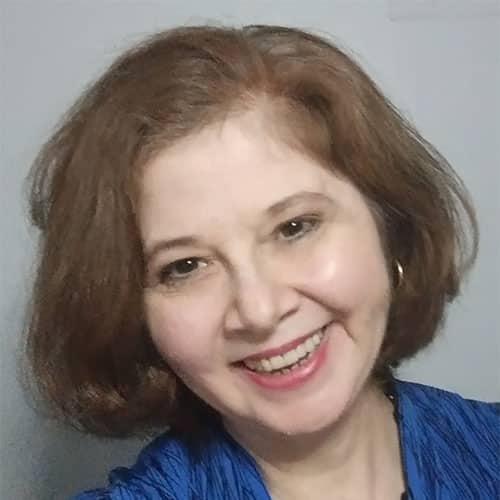 Photos courtesy Caron Tabb
Photos courtesy Caron Tabb What if you could bring the world together with a needle and thread?
Caron Tabb’s quilt “Fabric of Humanity — Repairing My World,” which is showing at the Skirball Cultural Center until March 12, 2023, aims to do just that.
Tabb’s cascading 12 foot by 9 foot quilt has more than 1,500 pieces and includes meaningful fabrics from her friends and family around the world.
“These last few years, the world feels even more and more broken,” Tabb told the Journal.
Putting together the quilt “felt like I was broadening the sense of humanity,” she said. “And it felt very, very deeply Jewish to me in a profound way.”
Tabb, 57, was born in apartheid South Africa, from the age of 8 grew up on a farm in Israel and has spent the last 22 years in the United States. Her background is in the nonprofit world. However, after her family moved from the Bay Area to Boston around 11 years ago, Tabb was searching for her next thing. That’s when she found art.
“I picked up a paintbrush, and the rest is history,” she said.
Tabb considers herself an “Artivist,” someone who uses art to inspire others to have difficult conversations.
Tabb considers herself an “Artivist,” someone who uses art to inspire others to have difficult conversations.
“I’m finding that my work is the nexus of my Jewish identity, my social justice roots, being born in apartheid South Africa and growing up in Israel,” she said. “Everything’s coming together and now is showing up in my artwork.”
“Fabric of Humanity” started as a pandemic project. When the world was falling apart, Tabb wanted to find a way to bring people together.
“I started stitching because it was a very calming and soothing way for me to deal with everything that was happening around us,” Tabb said.
As she started putting swatches together, a friend remarked how incredible it was that the world was connected through a common enemy, COVID, for the first time since the Spanish flu.
“I had this sense that I wanted to bring my people to me,” Tabb said. “I wanted to be able to touch them and hug them and feel them.”
She also wanted to capture the magnitude of this moment in time.
“I sent out this letter via email to about 150 people who I love and care about around the world, and asked them to please send me a piece of fabric that’s meaningful to them,” Tabb said.
She asked them to explain why the fabrics were significant.
“Every day became Hanukkah in my mailbox,” Tabb said. “I couldn’t wait for the mailman to arrive because I was getting these unimaginable treasures. These heirlooms that people had saved, treasured and cherished — in some cases for generations — were now in my mailbox. [They were] entrusted to me to do something with them, and this would be the final resting place.”

Artifacts in the quilt range from a beautiful night cap that came from the old country through Ellis Island to a 60-year- old baby bonnet to a napkin from Lebanon.
“As this quilt grew, I realized that I was telling the story of history,” she said. “It was about the vibrance of the humanity, the incredible sense of community that we share and the depth and breadth of who I am, but more importantly, what I stand for and who is in my tribe.”
This quilt, which has been growing for the last two years, also has the letters that came with the fabric stitched onto the back of them. Tabb calls it the “back story.”
“The other thing that I love about this piece is, as the world was falling apart on the outside, I had these magic powers to put families back together,” she said. “I would stitch together families who lost a loved one.”
With her work, Tabb said she hopes people think about the treasured stories in their family and that they are inspired to capture their family’s history in a similar way.
When Tabb’s kids were growing up, they went to Jewish day school and would start every morning with the prayer Modeh Ani: “I give thanks for waking up every day in the morning.”
“I often reflect on that, that waking up in the morning is a gift, and for which I give much gratitude,” she said. “There’s something about, first of all, having my art in the Skirball … I have so much gratitude for that on a personal level. But I’m also grateful that I can use my voice to help others, that I can bring people along on this journey and encourage others to be on their own journey.”
“Fabric of Humanity” is part of an interactive exhibition, “Together for Good: Caron Tabb” and the “Quilting Corner,” at the Skirball. It’s displayed alongside an all-ages community quilt-making activity, the result of which will be accessioned into the Skirball’s collection. Tabb’s work and the Quilting Corner are born out of modern-day interpretations of tikkun olam (“repair the world”).
The Skirball is located at 2701 N. Sepulveda Blvd. in Los Angeles. For tickets and information, call 310.440.4500 or visit skirball.org.





















 More news and opinions than at a Shabbat dinner, right in your inbox.
More news and opinions than at a Shabbat dinner, right in your inbox.